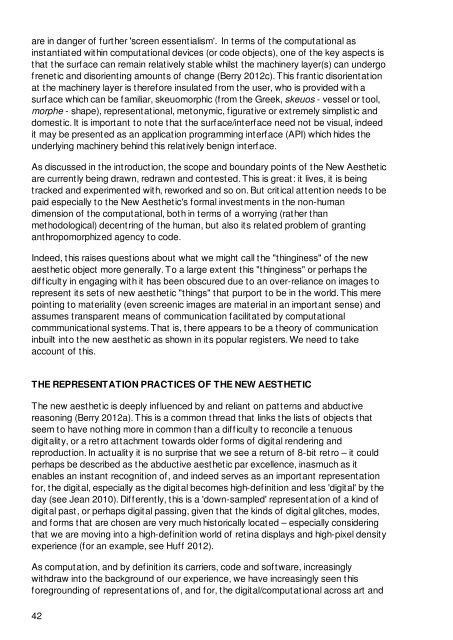New Aesthetic New Anxieties - Institute for the Unstable Media
New Aesthetic New Anxieties - Institute for the Unstable Media
New Aesthetic New Anxieties - Institute for the Unstable Media
Create successful ePaper yourself
Turn your PDF publications into a flip-book with our unique Google optimized e-Paper software.
are in danger of fur<strong>the</strong>r 'screen essentialism'. In terms of <strong>the</strong> computational asinstantiated within computational devices (or code objects), one of <strong>the</strong> key aspects isthat <strong>the</strong> surface can remain relatively stable whilst <strong>the</strong> machinery layer(s) can undergofrenetic and disorienting amounts of change (Berry 2012c). This frantic disorientationat <strong>the</strong> machinery layer is <strong>the</strong>re<strong>for</strong>e insulated from <strong>the</strong> user, who is provided with asurface which can be familiar, skeuomorphic (from <strong>the</strong> Greek, skeuos - vessel or tool,morphe - shape), representational, metonymic, figurative or extremely simplistic anddomestic. It is important to note that <strong>the</strong> surface/interface need not be visual, indeedit may be presented as an application programming interface (API) which hides <strong>the</strong>underlying machinery behind this relatively benign interface.As discussed in <strong>the</strong> introduction, <strong>the</strong> scope and boundary points of <strong>the</strong> <strong>New</strong> <strong>Aes<strong>the</strong>tic</strong>are currently being drawn, redrawn and contested. This is great: it lives, it is beingtracked and experimented with, reworked and so on. But critical attention needs to bepaid especially to <strong>the</strong> <strong>New</strong> <strong>Aes<strong>the</strong>tic</strong>'s <strong>for</strong>mal investments in <strong>the</strong> non-humandimension of <strong>the</strong> computational, both in terms of a worrying (ra<strong>the</strong>r thanmethodological) decentring of <strong>the</strong> human, but also its related problem of grantinganthropomorphized agency to code.Indeed, this raises questions about what we might call <strong>the</strong> "thinginess" of <strong>the</strong> newaes<strong>the</strong>tic object more generally. To a large extent this "thinginess" or perhaps <strong>the</strong>difficulty in engaging with it has been obscured due to an over-reliance on images torepresent its sets of new aes<strong>the</strong>tic "things" that purport to be in <strong>the</strong> world. This merepointing to materiality (even screenic images are material in an important sense) andassumes transparent means of communication facilitated by computationalcommmunicational systems. That is, <strong>the</strong>re appears to be a <strong>the</strong>ory of communicationinbuilt into <strong>the</strong> new aes<strong>the</strong>tic as shown in its popular registers. We need to takeaccount of this.THE REPRESENTATION PRACTICES OF THE NEW AESTHETICThe new aes<strong>the</strong>tic is deeply influenced by and reliant on patterns and abductivereasoning (Berry 2012a). This is a common thread that links <strong>the</strong> lists of objects thatseem to have nothing more in common than a difficulty to reconcile a tenuousdigitality, or a retro attachment towards older <strong>for</strong>ms of digital rendering andreproduction. In actuality it is no surprise that we see a return of 8-bit retro – it couldperhaps be described as <strong>the</strong> abductive aes<strong>the</strong>tic par excellence, inasmuch as itenables an instant recognition of, and indeed serves as an important representation<strong>for</strong>, <strong>the</strong> digital, especially as <strong>the</strong> digital becomes high-definition and less 'digital' by <strong>the</strong>day (see Jean 2010). Differently, this is a 'down-sampled' representation of a kind ofdigital past, or perhaps digital passing, given that <strong>the</strong> kinds of digital glitches, modes,and <strong>for</strong>ms that are chosen are very much historically located – especially consideringthat we are moving into a high-definition world of retina displays and high-pixel densityexperience (<strong>for</strong> an example, see Huff 2012).As computation, and by definition its carriers, code and software, increasinglywithdraw into <strong>the</strong> background of our experience, we have increasingly seen this<strong>for</strong>egrounding of representations of, and <strong>for</strong>, <strong>the</strong> digital/computational across art and42








